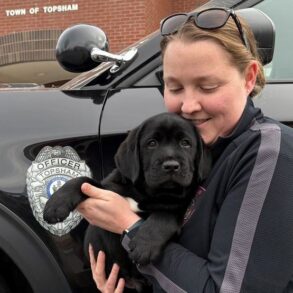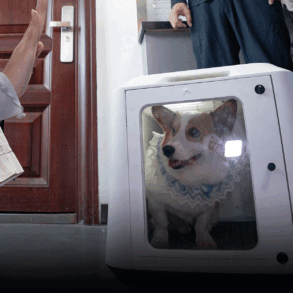Training dogs requires patience, consistency and using gestures or verbal commands, which canines understand through different tones, but new research found they might “listen in” on conversations even if it is not directed at them.
Owners often use dog-directed speech (DDS) when speaking with canines. This happy voice, similar to baby talk, occurs when someone uses increased intonation and pitch range, which attracts the dog’s attention. Dogs are more likely to follow commands efficiently when someone uses DDS.
But animal experts from the Universities of Lincoln and Sussex, in England, and the Jean Monnet University in France wanted to test whether dogs could understand and identify meaningful content, such as their name, buried among irrelevant sentences and spoken in a flat tone.

A stock image of a happy dog looking up with perky ears as someone pets him.
SeventyFour/Getty Images
The research group prerecorded the dog owners speaking a certain passage. The meaningful phrase included the dog’s name, followed by “come on now,” while the non-meaningful one stated “[Alfie / Bertie], pass me a coffee!” They compared both phrases when owners spoke in DDS and when using a monotone voice.
About 50 dogs of different breeds, such as dachshunds and St. Bernards, listened to the recordings in a room with their owners’ backs to them. Researchers measured the occurrence and durations of the dogs’ gaze at their owners after hearing a familiar phrase.
The study, published on April 12 in the journal Animal Cognition, found dogs were more likely to respond to the meaningful phrases when spoken with DDS prosody (stress and intonation); however, they could still detect their names among neutral reading prosody. Researchers noted that the dog’s ability to recognize speech could also have been aided by the pauses owners made in their recording.
They found that a dog’s brain can sift through speech without exaggerated cues, tones and movements, which previously was believed to be unique to humans.
The tests also evaluated the dogs’ response to speech based on gender. While women produce more exaggerated DDS speech than men and compared to their neutral reading speech, the study found that sex did not influence the dogs’ responses.
Dr. Holly Root-Gutteridge, Postdoctoral Research Fellow at the University of Lincoln, said in a statement: “We found that dogs could absolutely find their name when presented in a monotone way and buried in a stream of irrelevant speech—a prerequisite for comprehending language—and shows how good they are at listening to us.”
These findings could be an advantage for training service dogs, the team said.
Project leader, Professor David Reby at the University of Saint Etienne and visiting Professor at the University of Sussex, said: “The fact that basic verbal information can be perceived by a species that does not speak either indicates that human speech exploits perceptual abilities present in other mammals, or that dogs have a special ear for human speech as a consequence of domestication.”
Further research could be done on other animals—such as tame wolves, puppies, cats and horses—to investigate whether other domesticated species regularly exposed to human speech also respond the same way.
Do you have a tip on a science story that Newsweek should be covering? Do you have a question about dogs? Let us know via science@newsweek.com.
Reference
Root-Gutteridge, H., Korzeniowska, A., Ratcliffe, V., & Reby, D. (2025). Domestic dogs (Canis familiaris) recognise meaningful content in monotonous streams of read speech. Animal Cognition, 28(1), 29. https://doi.org/10.1007/s10071-025-01948-z
This post was originally published on this site be sure to check out more of their content.










































